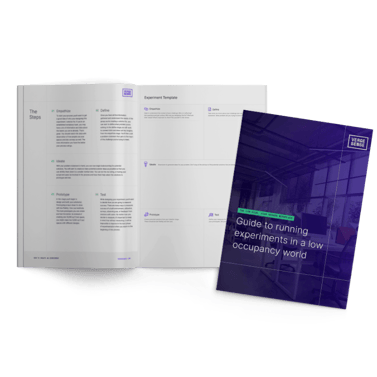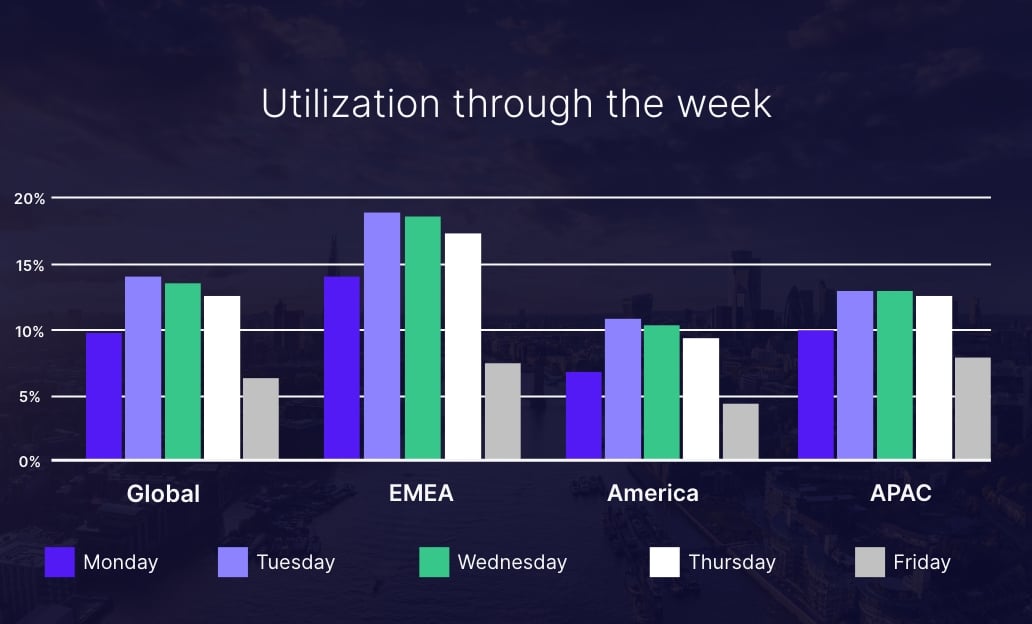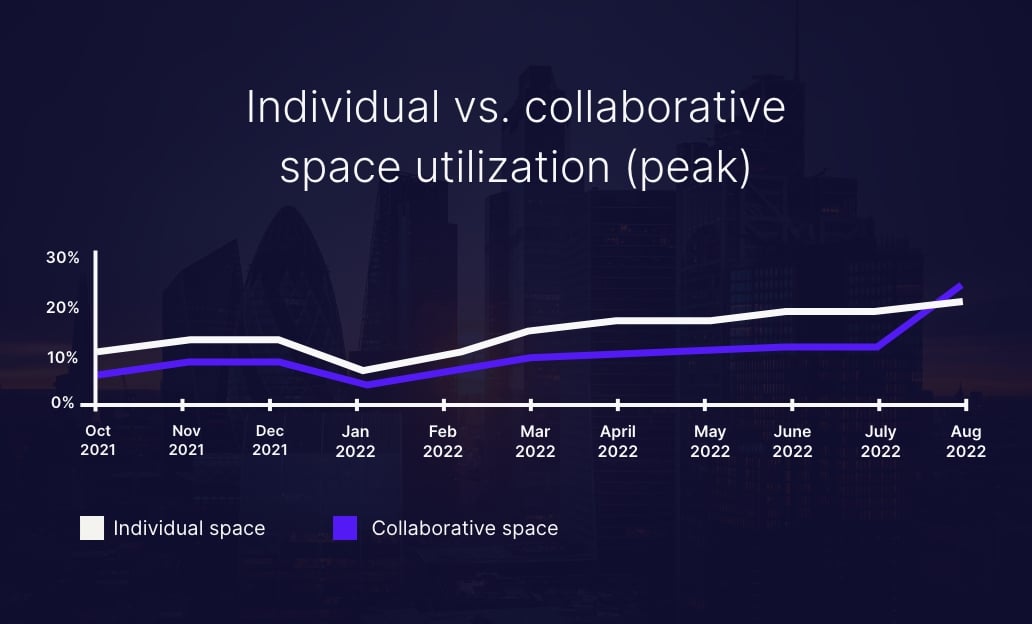Five Experiments For Building Your New Workplace Standards For 2023

VergeSense is the industry leader in providing enterprises with a true understanding of their occupancy and how their offices are actually being used.
Changes in workplace expectations have created unique challenges for those working in office design. But it is also an incredible opportunity for companies to experiment with different floor plans and develop new standards as they adjust to the new normal of work.
How might your company leverage its commercial office space to meet the needs of hybrid work?In this shifting landscape, there is ample opportunity to adjust your real estate portfolio to be more cost-effective, sustainable, and suitable to employee needs. And experiments are the quickest, low-risk method to determine which office layout is the right fit for you.
What is office space planning?
Office space planning is the strategy behind optimizing your square footage. It is the thought behind creating an efficient, functional, and well-utilized space that meets employee needs and enhances their productivity.
Why is office space planning so important? Behind employee salaries, commercial real estate is the highest line item in a company's budget. It is vital to a company's bottom line to make sure that space is fully utilized.
Beyond costs, well-designed spaces boost employee productivity and satisfaction. Within the current workplace landscape, employees can choose whether to work from home, in a third place (like a coffee shop), or a commercial office. The goal of office space planners is to create an inviting and valuable work environment that employees choose on-site over remote work. To do this, coming into work needs to be as frictionless—and thus, well-thought-through—as possible.
It’s time to shift our thinking about on-site occupancy
One of the most significant challenges commercial office planners face today is low occupancy. Many facilities managers are concerned with how few people are coming into the office. Countless conversations have taken place within upper management to figure out how to lure more employees back to working on-site.
But what if we stopped viewing low occupancy as a problem and instead saw it as the new normal? Flexible work environments are here to stay. The time of all employees working in the same building at the same time is a bygone era. So what does that mean for office space planning?
How post-pandemic occupancy affects space planning
Space planning used to be a simple formula of the number of employees times needed square footage per employee. There would, of course, be some divergence between the two. For example, some space would be underutilized when employees were on vacation or parental leave. But for the most part, these two factors worked hand in hand.
But after concerns for health and safety disrupted our ability to work in the office, the number of employees and the needed square footage in a workplace have entirely diverged. You might have hundreds of employees, with only a third working on-site on any given day. Should you then altogether downsize your office? Is it worth leasing an entirely new office space?
Image 1: More than 50% of weekly space utilization globally takes place on Tuesdays and Wednesdays, with the lowest workplace attendance on Fridays. Source: Regional Utilization Report
And, of course, there is the question causing all office planners to pause before making final decisions: what if everyone grows tired of remote work and wants to come back to the office? What would you do then?
Create your own template for your company’s specific needs
As office space planners, looking at other companies for ideas and affirmation is tempting.
Are others consolidating office space? How many square feet is a similarly-sized company using? Should you move to a coworking space? While it is helpful to garner ideas from other people, keeping your employees' and your company's needs at the top of your mind is essential.
Gartner, the leading consulting firm for executives, may suggest that companies should aim for 20% occupancy. But what if only 2% of your employees come into the office? If you take Gartner's suggestion point blank, you might lose sleep at night trying to figure out how to lure another 18% of your employees back to the office.
Similarly, Google revolutionized workplace expectations with all of its outstanding amenities. Were you to add some flashy break rooms and sleek furniture, would employees come flocking back?
The answer is no. And hopefully, you aren't actually losing sleep at night. (But if you are, we have solutions that will help relieve your stress)
Extensive analyst reports, like the ones that Gartner releases, are great for seeing overall trends across all workspaces. But if you interpret the data to mean you must fit that mold at all costs, you will lose much more than just sleep. Your employees need to feel seen and heard, and that means creating office floor plans that meet their specific needs.
Google has researchers and scientists figuring out precisely what type of office works best for Google. Feel confident that you will find the right solutions for your business through your research and assessment of your company.
The importance of conducting office space experiments
And that is why experiments are so helpful.
With fewer people in the office, understanding how they use the space (best accomplished through occupancy sensors and spatial intelligence) becomes even more critical. This real-time, anonymous information allows you to make data-driven workplace design decisions.
These are the 5 steps of any experiment:

You might have million-dollar assets or billions of dollars in your portfolio–or you might have a much smaller CRE. But either way, it is a considerable risk to change your lease, sell property, or renovate your space without doing the proper leg work first.
Experiments allow you to prototype, collect crucial data, and see how employees respond to the new work environment before making permanent changes. It is important to run small, targeted experiments for at least 90-120 days. You don’t want to make big changes flippantly. You want to allow time for employees to settle into the space and see what works and what doesn't before you iterate again.
Here are five accessible experiments to conduct in your workplace over the next year.
Experiment #1: Play with the total size of your office space
We all know the peace of being in a well-designed and right-sized space. Too large, and it can feel overwhelming and cavernous. Too small, and it can feel cramped and restricting. But just right, and we feel settled and inspired. Goldilocks was certainly onto something.
Because the proper size of an office has shifted significantly in the past few years, it is necessary to reassess your real estate portfolio. By right-sizing your workplace, you will ensure that each office is adequately sized, in the right location, and ready to support future needs.
So, how do you do this?
The first step is to take inventory. How many locations do you have? How many floors are in each of those locations? Consider also how many employees are using each site and even each floor. This information will prepare you to conduct your first experiment.
Right size your portfolio to lower operational costs
Let's say you have three office locations, two of which are more regularly utilized. Your first experiment could be to close the less popular location.
Temporarily closing underutilized space will immediately start to save you money. Of course, you will continue to pay the lease, but you will save on the cost of operations, cleaning crew, and other amenities. Concentrating employees in a smaller area will also improve camaraderie, collaboration, and overall experience in the office.
Remember to allow time for employees to settle into the new normal. Once you've collected data for a significant amount of time, you can start asking clarifying questions and drawing conclusions.
After closing the third office location, you may notice those employees opted to work remotely instead of at one of the other two locations. Why? Was the third office more centrally located for them? Did that office space have amenities the other two didn't?
Or maybe you found employees seamlessly transitioned to working at one of the other locations. After conducting an employee survey, you might realize that closing the location had no significant repercussions for employee satisfaction and productivity.
This experiment also works with the number of floors you have in an office. Let’s say you have six floors and only a third of your staff works on-site. Many floors, and many amenities on each floor, sit idle as the space is too big for the number of staff. Choose one or two floors with the best amenities and close the others.
A tangential experiment you could conduct would be to sublease the extra space you've now identified. Or, if restricted by your lease, get creative with how you might use the area. Instead of spending additional revenue on venues, could you host a conference, employee workshops, or other events in that third office?
Once you have identified the proper amount of total space you need, you can experiment with just how much square footage you should allocate for each type of space.
Experiment #2: Test the popularity of various space types
Space utilization, put simply, is the capacity of an area divided by its occupancy. Or, more specifically, how many people a conference room can hold divided by how many people use it over a period of time. Office utilization data can be used for office space planning and is often collected as part of a larger workplace strategy or corporate real estate optimization strategy.
Let's say a conference room can hold twenty people. Over the past six months, only ten people have used it at a time. The space utilization then is 50%.
But drill down a bit further, and you can start to ask more interesting questions. Was the conference room used for any other purposes than just large meetings? Does this conference room offer the best technology? Were more popular rooms booked and this was the next best option?
By taking in the data and analyzing it further, you can garner a robust understanding of which spaces employees gravitate to and why. And from there, you can start to see which spaces you need more and which you need less.
Create new space utilization standards
With this experiment, you are looking to see which spaces are used most often. By right-sizing your space in the first experiment, you also densified your occupancy. Once a workplace, be it an entire office or just one floor, is more fully occupied, you can start to see where, when, and how your employees use the spaces.
This is where comprehensive platforms like VergeSense are incredibly valuable. Not only can you know what areas are being used and when, but you can also accurately analyze that information.
Maybe your employees gravitate toward the floors with the most huddle rooms. Or perhaps employees are spending significant time brainstorming with one another at large collaborative tables. On the flip side, maybe you notice that your phone booths are hardly ever utilized.
Start to test your amenities. What if you transform two of the six phone booths into another huddle room? Or take out a row of cubicles to add another communal table?
Again, run the experiment for 90 to 120 days to see how employees respond to the new space over time.
Here are some space utilization standards to help:
The amount of square footage needed will vary wildly depending on the industry, department, employee preferences, and even the office's location. But it is still helpful to know ballpark numbers.
According to iOffice, these are some good numbers to go by:
- Individual/1-1 spaces: 1-2 occupants, 50 square feet
- Huddle rooms: 2-6 occupants, 150 square feet
- Conference rooms: 6-20 occupants, 150-500+ square feet
- Lounge areas: 5-20 occupants, 500+ square feet
*Note these numbers are per occupant, not per employee. You might have remote employees that do not require any square footage in the office space.
Experiment #3: Assess whether you have the right balance of individual and collaborative spaces
At this point, you have assessed your amount of space. You have understood how, when, and why it is being used. And now, it is time to apply your new knowledge to the overall design and feel of the office.
Armed with real-time data—and results from previously conducted low-risk experiments—you can make informed decisions about your workplace design.
Were there a number of visitors cramped by the front desk waiting to be called back to meet with an employee? If so, you might need to expand your receptionist area. Did your employees gravitate toward a particularly-sized conference room again and again? Maybe you need to add in a few more of those types of rooms.
Do employees tend to congregate in the open seating areas? Do they meet regularly in conference rooms? Are the phone booths in constant use? This kind of data leads you to the third experiment you can try.
Build standards for your seating arrangements
This experiment would be wise to pilot with a specific department in your company.
Let’s imagine your sales team is on-board for a little office refresh. Traditionally, most of the team worked in cubicles, with a few in private offices. But now, with fewer people working on-site—and most coming in to collaborate—the department's design could use some restructuring.
Consider replacing the cubicles with an open-concept floor plan. How does the team respond? Do they like having each other more accessible or prefer more individual spaces?
You could even keep some cubicles and replace the others with communal tables. And then monitor to see which ones are used most frequently.
This will give you insight into the overall design of the space. Do your employees feel they have the right balance of areas to meet, mingle, and work together and places to accomplish sustained, focused work?
Of course, this experiment needs to be conducted with each department, as each will have different preferences and needs.
Image 2: Utilization of collaborative spaces is on the rise, and in August, superseded that of individual spaces.
It is also important to note that data from this experiment could be inherently skewed. As we have seen in recent workplace trends, people are coming into the office to collaborate. Thus, when only assessing on-site employee behavior, it is likely that you will find collaborative spaces to be more popular. Keep this in mind as you plan for future workplace needs and trends.
Experiment #4: Pilot a new seating ratio
Up until now, you have been assessing your physical space. Now, it is time to shift to thinking about your actual employees. Categorize your employees into three buckets: fully remote, fully on-site, and hybrid.
The fully remote employees can be disregarded from your calculations, as they will not need desk space in the office. With the other two, assign each employee a numerical value based on the time spent in the office.
An on-site employee should be given the value of 1. A hybrid employee who comes into the office a quarter of the time should be given the value of 0.25, while one who comes in half the time, 0.5, and so on.
Add up the number of on-site employees. The traditional 1:1 ratio of desk to employee still applies for them: 50 employees in the office full-time means you need 50 desks.
For hybrid employees, the calculation of the numbers is a little more nuanced. Let's say Anne comes into the office three days a week, and Bob comes in two. Given your company culture and office design, would it be possible for Anne and Bob to share a desk? This would mean that Anne, as a 0.6, and Bob, as a 0.4, equal one desk together. How many other hybrid workers might add up to one individual desk?
This type of assessment, of course, needs to be regularly reassessed. You might find that more of your hybrid employees work in the office on Tuesdays and Thursdays and fewer on Mondays and Fridays. If that is the case, you'd need more desks than you initially thought. To help with this, you could implement a system such as hot desking.
Standardize your employee-to-seat ratio
Similar to experiment #3, choose one team or department with which to try this experiment. Attempt hot desking among a particular group of hybrid employees and see how they like it.
Play with what makes sense for your company and see what ratio of desks to employees works best. But remember, be gradual with seating ratio changes. You want to avoid taking away too many workstations at once and risk leaving an employee without an available workstation.
Experiment #5: Test amenities for quality and use
Throughout this process, you have assessed your workplace from different angles:
- Total square footage
- Space usage
- The balance of individual and collaborative areas
- The actual employees themselves
Now it's time to focus on quality across all departments, floors, and locations.
By now, you are clear about which spaces employees are drawn to and why. You have noticed that employees regularly book a particular conference room because, even though it is too large for their meeting, it has the best technology for virtual meetings. And you have seen that employees choose to work from the fourth floor because it has access to the best kitchen and cafeteria.
Whatever the data shows you, it is essential to note the quality of each of these popular spaces—and potentially, the lack of it in the others.
Create standards around workplace quality and amenities
Choose one or two underutilized areas and update the technology in them. Maybe you purchase new video conferencing technology or roll out a platform for reserving desk space.
If a conference room is close to the breakroom, consider soundproofing it. It could just be that noise from other employees is distracting.
You could also consider adding pods for nursing mothers, exercise rooms, or classroom facilities. Even just increasing the quality of the chairs in the room might go a long way.
Get started on those experiments!
 Experimenting and collecting real-time data is vital to understand what your managers and employees genuinely need. One of the most challenging pieces of office space planning is reconciling the gap between what people say they want and need and what they actually use.
Experimenting and collecting real-time data is vital to understand what your managers and employees genuinely need. One of the most challenging pieces of office space planning is reconciling the gap between what people say they want and need and what they actually use.
Experiments help you to see what happens day in and day out. Paired with real-time data and expert analysts, you will be empowered to make informed decisions as you carry out low-risk, high-return experiments in the workplace.
Learn more about experimentation by downloading the free guide on how to run experiments in a low occupancy world.

